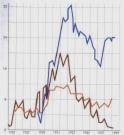
Towards a new crisis of 29
1. In one week, the exchange rate of the Japanese currency has regained around 5% against the dollar and the euro, but this rebound has nothing to do with any improvement in the Japanese economy. In fact, for many months, the Japanese currency has served the interests of speculative funds and all investors who appreciate only one thing in it: its low interest rate. Borrowing in yen costs practically nothing since the Bank of Japan has just raised the price of silver to 0.5%, which had been hanging around at 0.25% for several months. What could be more tempting than to borrow yen, resell them for another currency and place the dollars or euros thus obtained on very profitable markets. Investing in shares of emerging countries, high-yield bonds or the New Zealand market more than more than covers the cost of borrowing in yen. This is the famous carry trade that makes every good manager happy today. Even! More and more Romanians and Lithuanians are also borrowing in yen to finance their property purchases! In neighboring Hungary, the Swiss franc, another low-interest currency, is particularly popular for property loans. What are the amounts involved? According to Barclays Capital bank, at the end of 2006, net speculative carry trade positions amounted to more than $30 billion. A record amount. The Japanese Deputy Minister of Finance, Hiroshi Watanabe, speaks of a total market of between 80 and 160 billion dollars. On this basis, the rise in the yen over the past ten days would amount to a potential loss for speculators of between $3.1 and $6.2 billion. (Le Figaro.fr, 06/03/2007).
 2.Global stock markets rebounded on Tuesday after five consecutive sessions in the red and an unprecedented decline in four years, with investors taking advantage of the fall in prices to buy shares at attractive prices (…). But most experts underline the fragility of this rebound, the continuation of which will depend on the next signals on the health of the American economy. “The markets are catching their breath a little, but the question is how long this will last,” said the strategist of a French stockbroking company. “Everyone is already waiting for Friday’s US employment figures, which are closely watched given fears about the real state of the US economy.” The question is: will this rebound continue?, added Lisa Jarvis, analyst at ABN Amro Morgans in Sydney. “A lot of people think the correction will continue for four to six weeks, maybe eight weeks. It may just be a temporary lull, I don’t know if we’re out of the woods,” he said. she adds. On the foreign exchange market, the euro and dollar also recovered against the yen on Tuesday, thanks to the stock market lull and after reassuring remarks from the American Secretary of the Treasury, visiting Asia. “We agreed that the fundamentals of the global economy are strong,” and “we share the view that markets should reflect this,” Japanese Finance Minister Koji Omi said. , following a meeting in Tokyo with Mr. Paulson (Belga, 03/06/2007).
2.Global stock markets rebounded on Tuesday after five consecutive sessions in the red and an unprecedented decline in four years, with investors taking advantage of the fall in prices to buy shares at attractive prices (…). But most experts underline the fragility of this rebound, the continuation of which will depend on the next signals on the health of the American economy. “The markets are catching their breath a little, but the question is how long this will last,” said the strategist of a French stockbroking company. “Everyone is already waiting for Friday’s US employment figures, which are closely watched given fears about the real state of the US economy.” The question is: will this rebound continue?, added Lisa Jarvis, analyst at ABN Amro Morgans in Sydney. “A lot of people think the correction will continue for four to six weeks, maybe eight weeks. It may just be a temporary lull, I don’t know if we’re out of the woods,” he said. she adds. On the foreign exchange market, the euro and dollar also recovered against the yen on Tuesday, thanks to the stock market lull and after reassuring remarks from the American Secretary of the Treasury, visiting Asia. “We agreed that the fundamentals of the global economy are strong,” and “we share the view that markets should reflect this,” Japanese Finance Minister Koji Omi said. , following a meeting in Tokyo with Mr. Paulson (Belga, 03/06/2007).
 The economy relies more and more on international flows of profitable investments (stock markets, trust companies, international pension funds, etc.). This prevalence of speculation on production runs the risk of a general panic in the event of a collapse of prices in a given region or sector. Given the deregulation that has taken place over the last two decades, the fall in the stock markets that could ensue would spread at an unprecedented speed and without any restriction. The economy would be suffocated, with investments in free fall, due to the collapse of the capital market where industrial firms and governments borrow. As companies, which increasingly rely on stock market financing, are no longer able to finance their liabilities, we would see chain bankruptcies and an explosion in unemployment. The Asian crisis that occurred around ten years ago followed by the Latin American crisis were significant shocks, perhaps warning signs. In these types of cases, the IMF, central banks and governments have so far been able to plug the gaps; However, these regulatory bodies would be overwhelmed in the event of a large-scale crisis.
The economy relies more and more on international flows of profitable investments (stock markets, trust companies, international pension funds, etc.). This prevalence of speculation on production runs the risk of a general panic in the event of a collapse of prices in a given region or sector. Given the deregulation that has taken place over the last two decades, the fall in the stock markets that could ensue would spread at an unprecedented speed and without any restriction. The economy would be suffocated, with investments in free fall, due to the collapse of the capital market where industrial firms and governments borrow. As companies, which increasingly rely on stock market financing, are no longer able to finance their liabilities, we would see chain bankruptcies and an explosion in unemployment. The Asian crisis that occurred around ten years ago followed by the Latin American crisis were significant shocks, perhaps warning signs. In these types of cases, the IMF, central banks and governments have so far been able to plug the gaps; However, these regulatory bodies would be overwhelmed in the event of a large-scale crisis.

The conditions for the outbreak of the 1929 crisis are quite similar to current conditions. The period preceding the crash was marked by a divergence in developments between production and stock prices. Between 1921 and 1929, industrial production increased by 50%, but the total price increase over the same period was 300%. Stock prices increased more than corporate profits, which themselves increased more than production, productivity, and finally wages. A speculative element developed, because it was no longer dividends that attracted investors, but the possibility of reselling at a significant capital gain, many securities being purchased on credit for this purpose. The productive economy had been slowing down since the beginning of 1929, partly due to a phenomenon of asphyxiation, with available capital going to the stock market rather than to the real economy.
After prices reached a record high in October 1929, and a few days before the crash, the first massive sales took place. These were still profit takings, but they began to drag prices down. Thursday October 24 marked the first real panic. In the morning, there were almost no buyers, whatever the price, and prices collapsed. By midday, the Dow had lost 22.6%. After an emergency meeting, five of New York’s leading bankers said: “There has been a small amount of underselling on the stock exchange due to technical market conditions. The consensus from our group is that most of the stock market quotes do not accurately represent the situation. The situation is likely to improve…”










